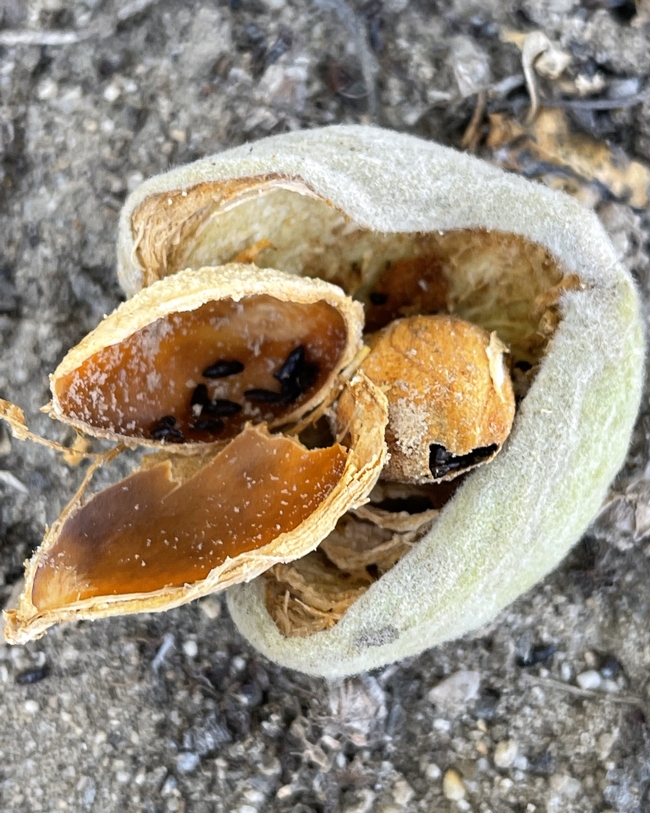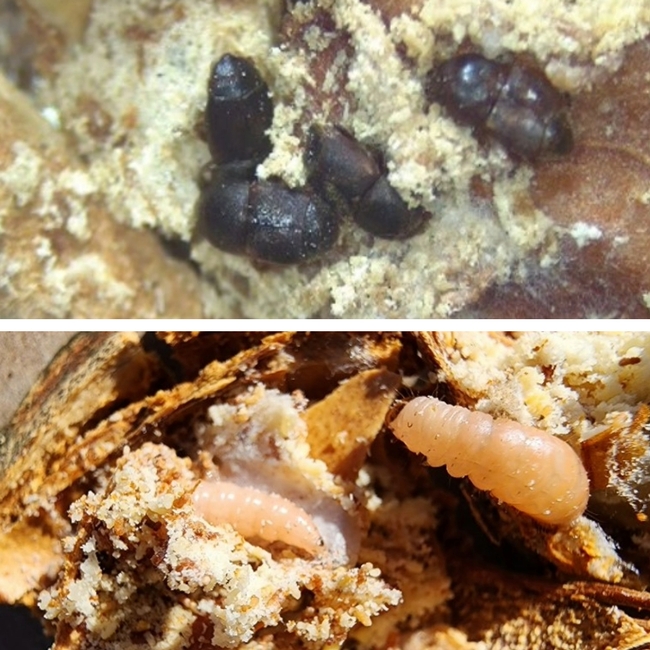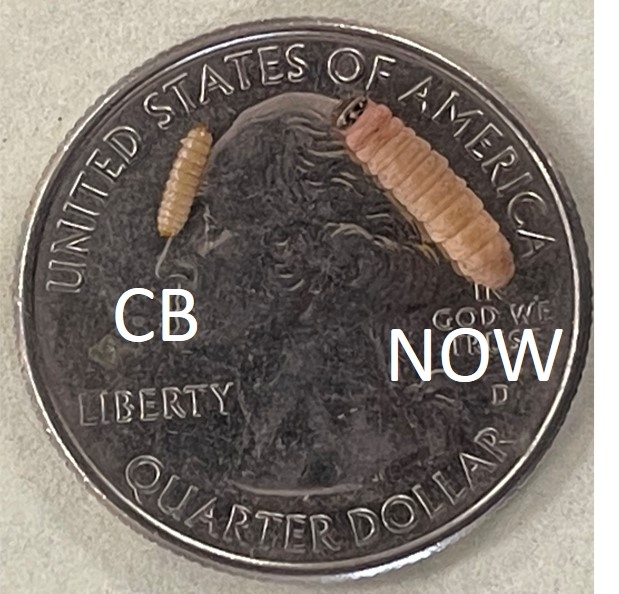
Posts Tagged: Integrated Pest Management
Visual ID guide from UC aids in managing new almond pest
Nut orchard hygiene key to control carpophilus beetle, say UCCE, UC Integrated Pest Management experts
Since the first reports of a new almond pest – the carpophilus beetle (Carpophilus truncatus) – came in during fall 2023, it has become clear that the beetle is widely dispersed across the San Joaquin Valley.
“My lab has identified infestations from every county in the San Joaquin Valley; we have found infestations in both almonds and pistachios, and we will likely find infestations in walnuts this fall,” said Houston Wilson, a University of California Cooperative Extension entomology specialist at UC Riverside. The California Department of Food and Agriculture has confirmed the beetle's presence in Stanislaus, Merced, Madera and Kings counties.
Historically a major threat to almond production in Australia, the beetle – as larvae and adults – feeds directly on the nut kernel. In California, some almond growers have lost 10 to 15% of their yield – a “significant economic loss,” according to Jhalendra Rijal, University of California integrated pest management (IPM) advisor for the region. Given the prominence of almonds as a commodity, even a 1% overall reduction statewide represents an approximately $70 million loss.
“This year there has been a lot more reports from PCAs [pest control advisers]; they're sending me the pictures of the damage and beetles,” said Rijal, noting that the increase is likely due to greater awareness of the pest.
To help almond growers identify the carpophilus beetle and develop management plans, Rijal, Wilson and their IPM colleagues have put together a visual ID guide for the beetle and the damage it causes, as well as telltale signs of navel orangeworm (Amyelois transitella) and ant damage. In particular, the experts would like PCAs and growers to differentiate between the carpophilus beetle and navel orangeworm, another key pest in almonds.
“Even though their way of causing damage looks more or less similar, we're dealing with two different types of insects,” Rijal explained. “One is a Lepidoptera moth [navel orangeworm], and the other one is a beetle – many of the management practices and biological controls would be different for these two different things.”
To control carpophilus beetle, ‘sanitize, sanitize, sanitize'
One crucial cultural practice for managing both pests, however, is destroying the remnant “mummy” nuts – the nuts that remain in the orchard postharvest. They serve as overwintering habitat for the carpophilus beetle, as well as its sustenance for the next generation of beetles in spring.
“The best way to manage this pest is to do the orchard hygiene – continuing the winter sanitation, destroying the nuts that are on the ground and on the tree and on the berms,” Rijal said.
Based on observations in Australia and locally, carpophilus beetles tend to rely more on mummies on the ground, whereas navel orangeworm generally favors mummies in the tree canopy. Correctly identifying the pest – with help from the new ID guide – enables growers to better target and prioritize their management efforts, Rijal said.
“What we are strongly emphasizing is that growers need to sanitize, sanitize, sanitize to control both pests,” Wilson added.
Correct identification of the pest would also prevent unnecessary application of insecticides, as those used for controlling Lepidoptera such as navel orangeworm would be largely ineffective on the beetle.
Indeed, another insight shared by Australian experts is that the carpophilus beetle cannot be controlled just by insecticide.
“Insecticides are not very efficient, given the cryptic nature of these beetles; exposing these beetles to the insecticide is very hard,” said Rijal, noting that the beetle spends most of its life cycle protected inside the nut.
Reporting carpophilus beetle infestation helps researchers
This harvest season, Rijal advises almond growers to harvest as efficiently as possible, to minimize the number of mummies that need to be cleaned up. And because signs of damage (like damaged hulls and frass) are most obvious during harvest time, Rijal said growers should review the new guide, using the photos and other resources to help identify potential pests.
If the grower or PCA suspects a carpophilus beetle infestation, they should contact the UCCE farm advisor in their area.
Scientists are looking to expand their knowledge about this relatively new pest to California. In the coming weeks, for example, researchers are planning to survey for the carpophilus beetle in the Sacramento Valley.
“Technically it has not been found there, but we suspect that we'll find it this fall when we go looking for it,” Wilson said.
Researchers are also collecting samples from infested orchards to better understand the biology of the species, as well as how it progresses through and responds to seasonal and climactic changes. In addition, they are analyzing data from a trial study of an insecticide that might be used as a supplemental control measure.
“This is our first full season dealing with this insect, and there are still many things we need to understand,” Rijal said. “We are continuing our research efforts on all fronts.”
The Katydid Nymph Did
The katydid nymph did. It did appear in May. The UC Statewide Integrated Pest Management Program (UC IPM) tells us that katydid nymphs appear in our gardens in April or May. This little nymph was right on time, barely, as it surfaced in our Vacaville garden on May 28. The nymph, a...
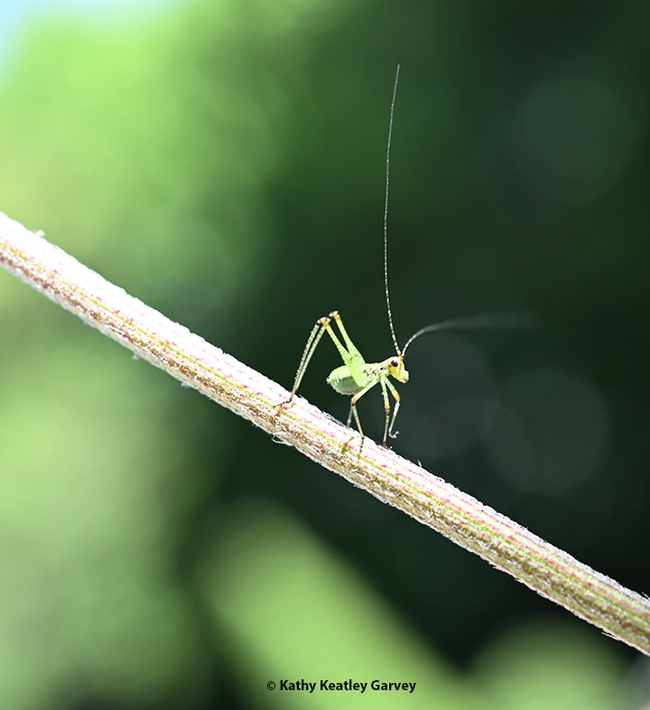
A katydid nymph, its long threadlike antennae upright, descends a stem in a Vacaville garden. (Photo by Kathy Keatley Garvey)
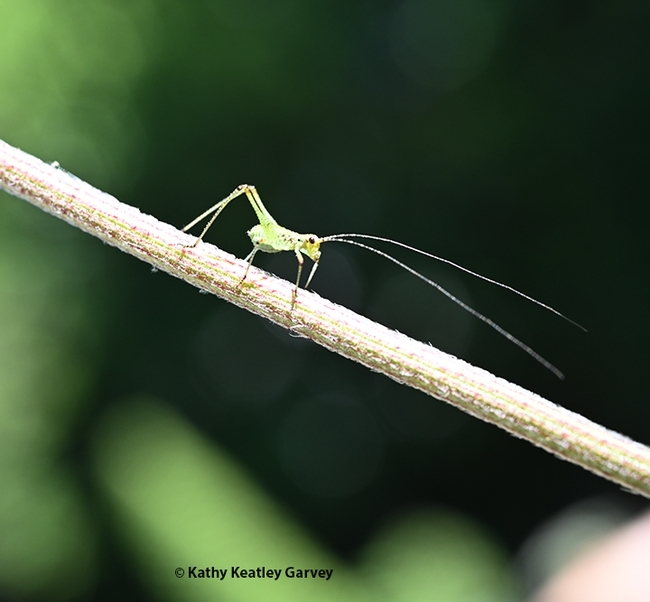
A katydid nymph, its long threadlike antennae upright, descends a stem in a Vacaville garden. (Photo by Kathy Keatley Garvey) The katydid nymph lowers its antennae and proceeds along the stem. (Photo by Kathy Keatley Garvey)
The katydid nymph lowers its antennae and proceeds along the stem. (Photo by Kathy Keatley Garvey)
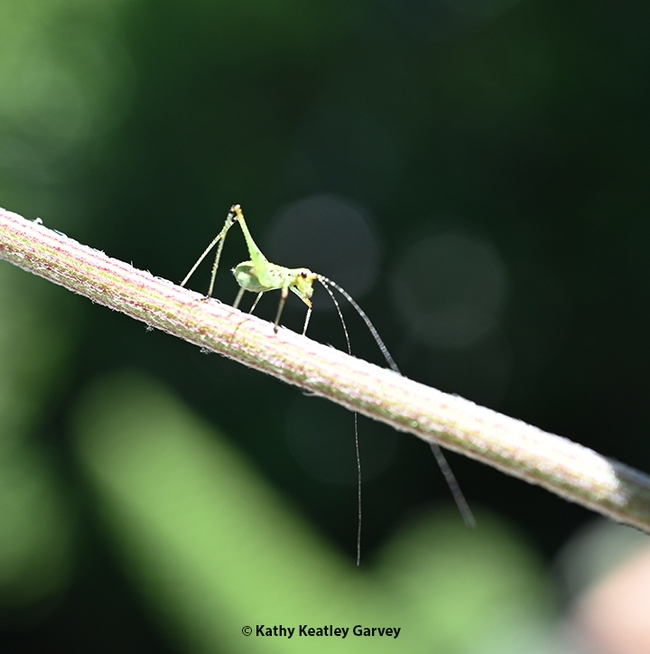
Antennae down, the katydid nymph continues its descent. (Photo by Kathy Keatley Garvey)
Frank Zalom: Lifetime IPM Achievement Award
His name is synonymous with integrated pest management (IPM) and his achievements during his 45-year career are nothing short of spectacular. So it's no surprise that UC Davis distinguished professor emeritus Frank Zalom, internationally recognized for his IPM expertise and...
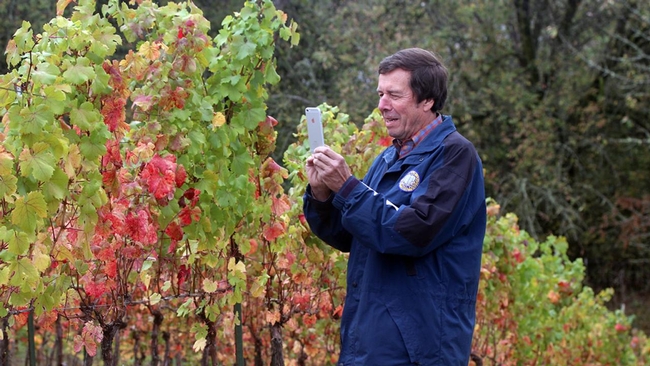
UC Davis distinguished professor emeritus Frank Zalom takes an image of a Willamette vineyard showing grapevine red blotch virus in the fall.
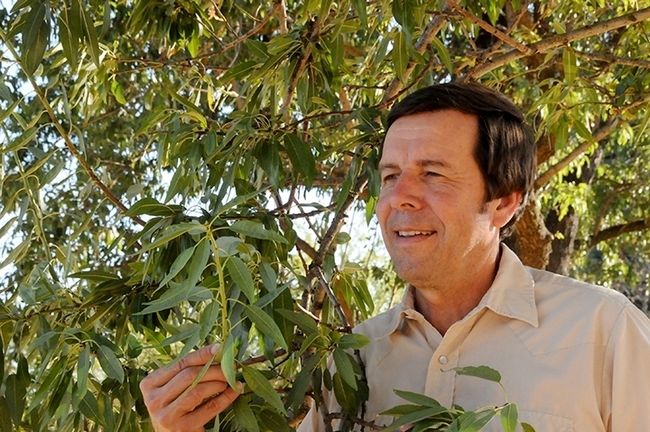
UC Davis distinguished professor emeritus Frank Zalom is highly honored for his work on almonds. (Photo by Kathy Keatley Garvey)
Spiked Forelegs of a Praying Mantis: There Is No Escape
A praying mantis, an incredible ambush predator, can lie in wait for hours for its prey. Often it's so camouflaged that it totally blends in with its habitat. It can rotate its head 180 degrees--and nothing, it seems, can escape its view. Praying mantises are not considered biological pest...
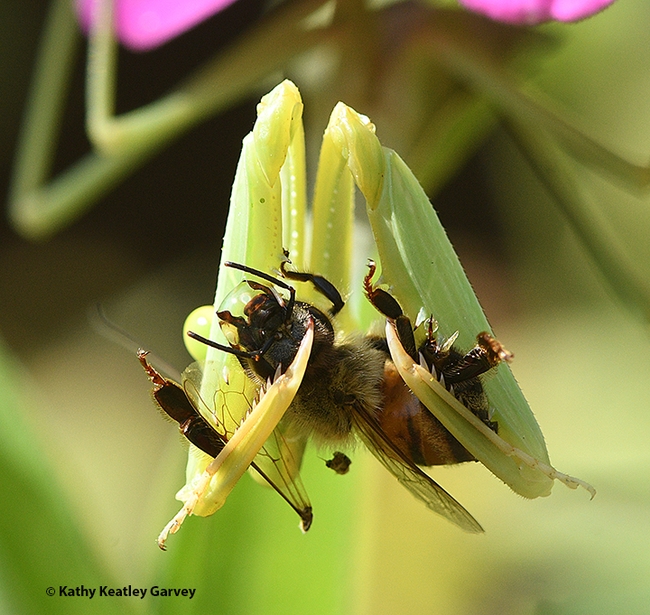
This praying mantis, Stagmomantis limbata, has just ambushed a honey bee and is grasping it in its spiked forelegs. There is no Harry Houdini-kind of escape. (Photo by Kathy Keatley Garvey)
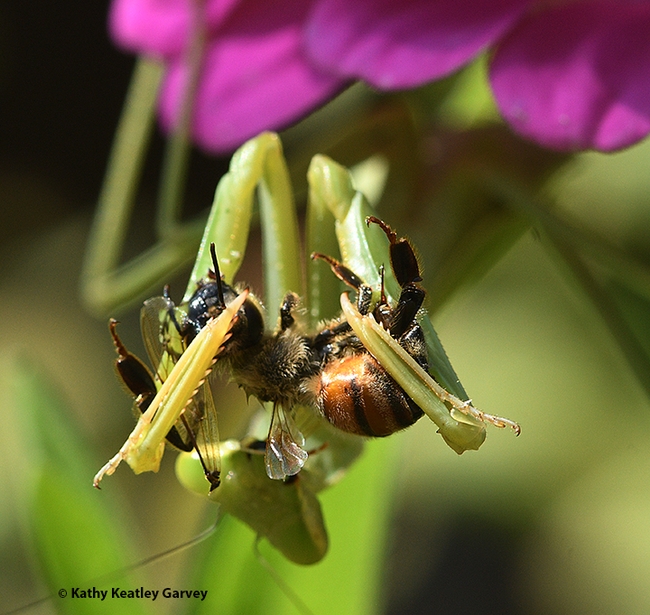
Death grip. With its two spiked forelegs, the praying mantis firmly grasps the honey bee. Photo by Kathy Keatley Garvey)
Those Goofy-Looking Cartoon Characters Called Crane Flies
Back in April of 2021, we wrote: "They're out there, and you don't have to crane your neck to see them." The topic: crane flies. They're often mistakenly called "mosquito eaters" or "mosquito hawks." They're neither. They're members of the family Tipulidae of the order Diptera (flies). Lynn...
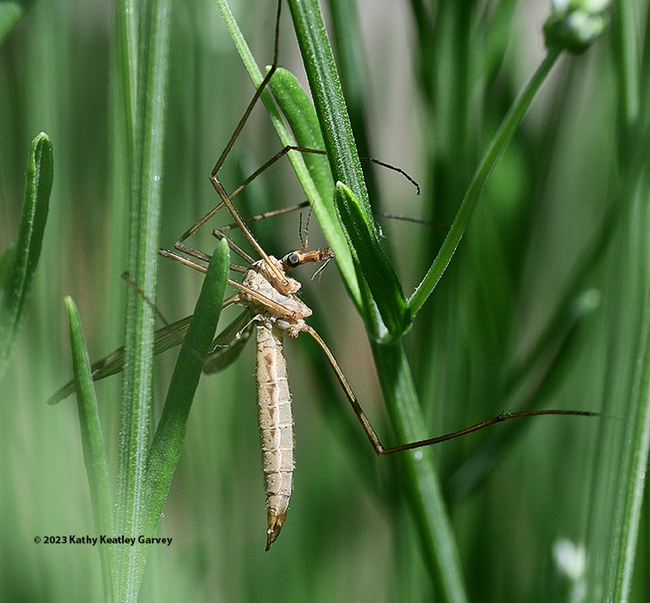
A crane fly resting in a Spanish lavender bed in Vacaville, Calif. Crane flies are sometimes called "mosquito eaters," but they do not eat mosquitoes. (Photo by Kathy Keatley Garvey)

